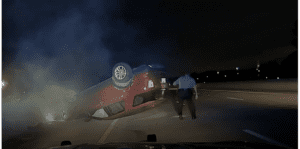Using Immersive Simulation in Vehicular Use-of-Force Training
Published

Last year vehicular use-of-force by law enforcement was again in the news after an Arkansas state trooper hit a pregnant woman’s car to enforce a traffic stop. This flipped the vehicle:

The inciting incident? The motorist was driving 84mph in a 70mph zone and took more than 2 minutes to pull over. Public outcry followed. In theory, the “precision immobilization technique” (or “PIT”) is an important law enforcement tool for quickly stopping a chase. By nudging the rear corner of the fleeing vehicle with the front corner of their own, officers can theoretically safely force the vehicle off the road.
But that theory often fails to meet practice. Previous analysis by the Washington Post found that more than half of the fatal PIT maneuvers over several years “came after officers tried to stop vehicles for minor traffic violations such as speeding.”
As the Post noted following this latest incident in Arkansas:
“Scrutiny of the tactic has grown amid a broader backlash against police use of force, as many say routine stops escalate needlessly. … [The motorist’s attorney] argues that the trooper not only used excessive force but also executed the PIT maneuver improperly, because the move should not cause a car to flip. He says [the motorist] was following the state driver manual’s instructions for people pulled over by law enforcement: Move to the right side of the road and use your turn signal or emergency lights to show police you’re looking for a safe place to stop.”
“Stress Overload” Leads to Inadvertent Excessive Force
Brian Brooks is the former deputy director of the Wyoming Law Enforcement Academy and an expert on training practices. “There’s a whole bunch of reasons that [excessive force incidents] happen,” Brooks notes. That includes vehicular use of force incidents, like PITs gone wrong. But stress is a major factor. “People hit a level of stress that, cognitively, they shut down.”
Brooks refers to this as “stress overload,” and notes that under these conditions it is practically impossible for anyone to reliably work through a complex evaluation of multiple factors.
According to Brooks, “That’s where simulator training is so important. We can actually get them exposure to [this level of stress] in a safe environment.” Officers can then practice proactively managing their stress levels. This leaves neural pathways open for evaluating complex situations and making critical judgements. “Once they get that exposure, gain that experience in a safe environment, then when they go out, they’re able to have a frame of reference.… Officers need to witness this outside of a stressful environment. They need to witness it in training so that they have a frame of reference later on.”
Brooks strongly advocates for sim training as an excellent way to prepare officers for (and protect them from) stress overload. This strategy is often called “stress inoculation,” and is increasingly popular among law enforcement agencies nationwide. This is especially the case with communication, de-escalation, and firearms training.
FAAC’s line of DrivingForce simulators are unique in bringing together vehicle operations, use-of-force decision making, and stress inoculation into continuous integrated exercises. DrivingForce is designed to create the visceral emotional experience of a stressful vehicle pursuit, creating an opportunity for officers to safely develop the personal decision-making framework they need to safely and selectively deploy force when needed.

